Art & Exhibitions
‘There Is a Desire to Shift the Gaze’: Meet the Artists Reimagining Old Masters Paintings to Challenge the Narratives of the Western Canon
Their works upend historical representations of race, gender and power.

Their works upend historical representations of race, gender and power.

Emily Steer

How can artists address violent and unjust aspects of the past while looking towards the future? For the contemporary painters who reframe the work of the Old Masters, this often involves replicating compositions and marks from the originals while confronting the gendered or racial hierarchies that underpin them.
Many play with the relationship between subject, viewer and artist, imbuing their figures with a powerful gaze. Others paint their own bodies into the work. In doing so, they challenge deep-rooted western narratives of art history and ask, crucially, who gets to tell these stories.
This month, Jake Grewal opens “Sometimes I Feel More Alive”, a solo show at Pallant House Gallery in Chichester. His paintings of nude figures in the wilderness evoke the inherent connection between humans and nature, and are suggestive of internal, psychological spaces.
The artist has previously described his practice as searching for a peaceful space of queer communion. His works are often inspired by canonical artists such as Constable, Degas and Gauguin. Grewal inserts his figures into passages borrowed from their landscape paintings, thereby placing himself as an artist within the heteronormative canon of art history.
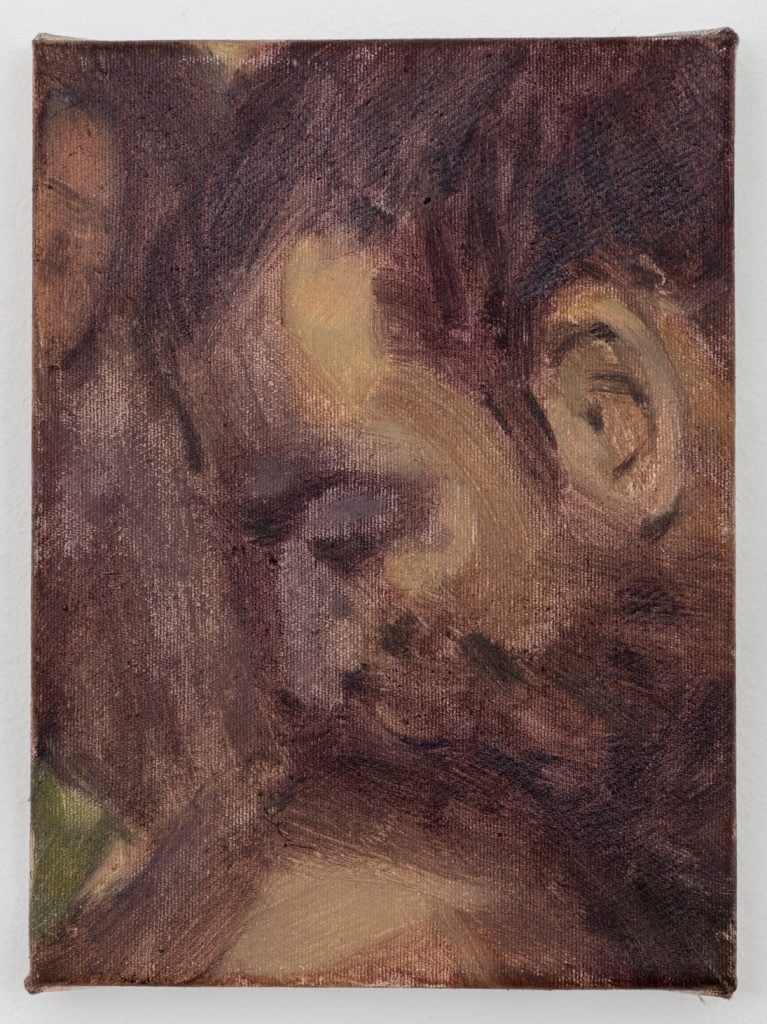
Jake Grewal, Eaten // Fled Tears (2021) © Jake Grewal. Courtesy the artist and Thomas Dane Gallery. Photo: Richard Ivey
“I was interested in the synergy between his work and the artists he is thinking about,” said Simon Martin, art historian and director of Pallant House Gallery. “But also, how he subverts their work and does something which feels very contemporary, while still having an appreciation for the language of the Old Masters. A lot of the Old Masters, except for a few such as Caravaggio or Il Sodoma [both were believed to be gay] were straight, white, male figures, and Jake is dealing with queer desire.”
Martin also highlights the gallery’s recent acquisition of Vanishing Point 24 (Mignard) (2021), an embossed drawing by Barbara Walker, who is nominated from this year’s Turner Prize. The drawing follows the composition of Pierre Mignard’s painting Louise de Kéroualle, Duchess of Portsmouth with an unknown female attendant (1682).
The “unknown female attendant” is a Black woman. In Walker’s reworking, renders the Black figure in pencil, while the duchess is nothing more than an impression, she is almost invisible. It is a potent example of very direct influence in terms of composition, while the focus within the original work is reimagined. “In looking at some of these themes in art history and exploring their resonance for contemporary audiences, we can ask how we might be able look at things differently,” said Martin.
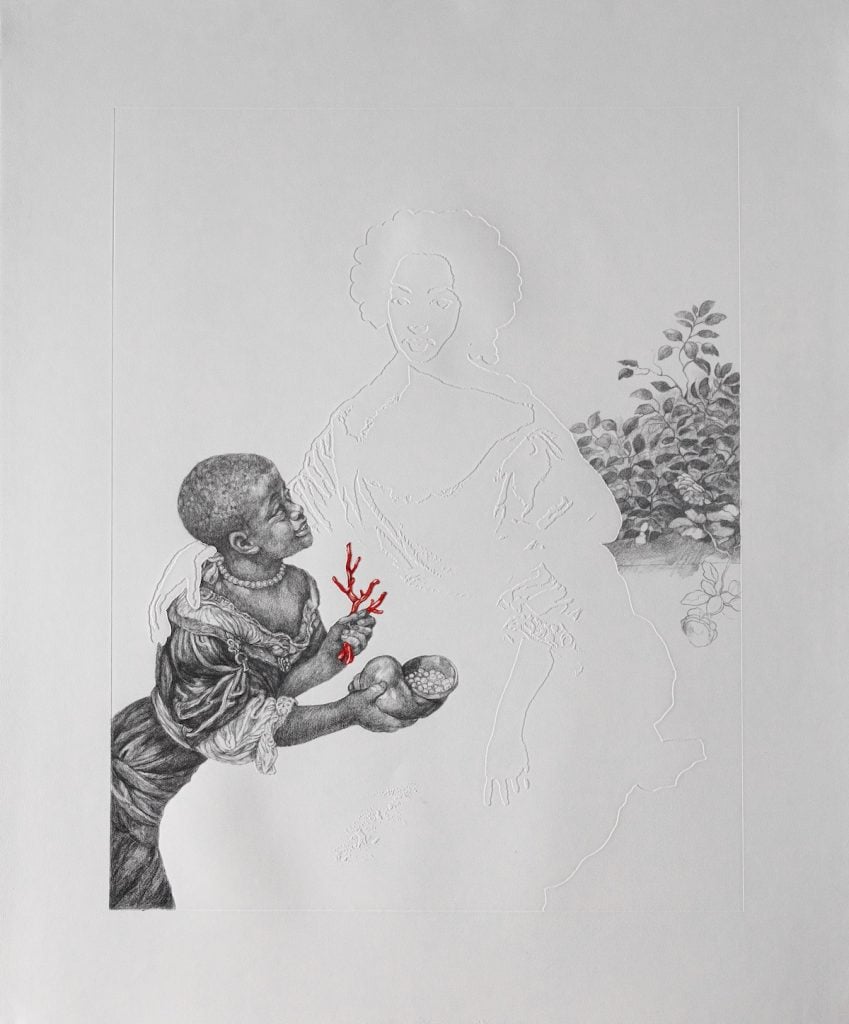
Barbara Walker, Vanishing Point 24 (Mignard) (2022) Photo: Chris Keenan
Many contemporary artists who subvert the work of the western canon interrogate the gaze implied by the originals, whether it be that of the artist or the suggested eyeline between the viewer and subject. The work of Jesse Mockrin (whose show just closed at James Cohan in New York) takes specific details and compositions from the likes of Caravaggio and Mignard, and imbues them with contemporary narratives, often addressing the gendered dynamic between artist and subject.
For “The Venus Effect”, Mockrin has researched historical paintings of women holding mirrors, in which the viewer might imagine she is looking egocentrically at her own reflection. In fact, she is looking seductively at the male artist. According to the gallery, “The mirror becomes the tool through which her sitters recognize themselves as both the object of desire and a powerful subject, whose agency is antithetical to their original narratives.”
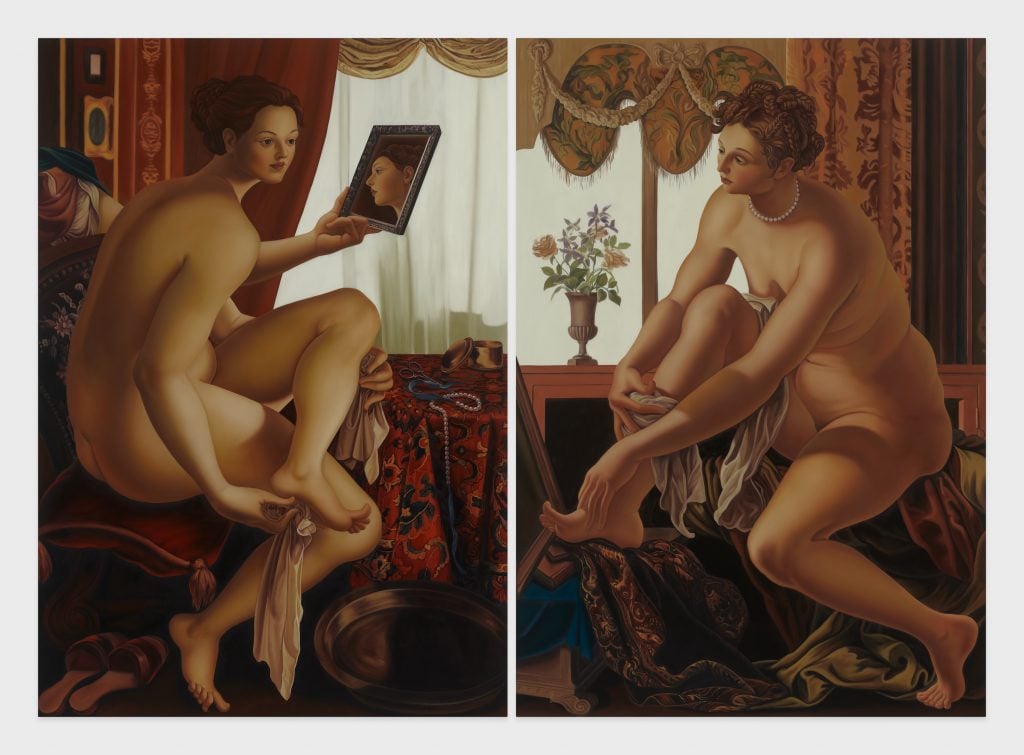
Jesse Mockrin, Echo (2023). © Jesse Mockrin 2023. Courtesy the artist; James Cohan, New York; and Night Gallery, Los Angeles. Photo by Marten Elder.
“Afternoon’s Darkness”, Somaya Critchlow’s 2022 exhibition at Maximillian William, featured a commanding gaze from many of her Black subjects, in works utilizing techniques from painters such as Leonardo da Vinci and Goya. In Count Me Out (2022), an almost nude figure lounges against the wall pulling her underwear down her thighs. Though the viewer can only really identify her eyelids, her gaze—which seems to be aimed at a figure below her out of frame—is one of self-assurance.
For this work Critchlow utilized sfumato, a technique devised by Leonardo, in which paint is thinly applied across the canvas, instilling a hazy presence which also evokes the misty lens of soft-core pornography. The artist claims she used the technique here to present her figure as powerful and in charge of her own sexuality.
“I imagine Somaya Critchlow’s work wouldn’t be received in the same way if it was a white man painting it,” said writer and art historian Alayo Akinkugbe, who hosts the podcast A Shared Gaze. “It’s frustrating constantly having to bring an artist’s racial identity into it but it is dependent on the artist’s own gaze. The gaze of the artist has typically led to idealized women’s bodies painted by men. Somaya is reconfiguring the Black female nude.”
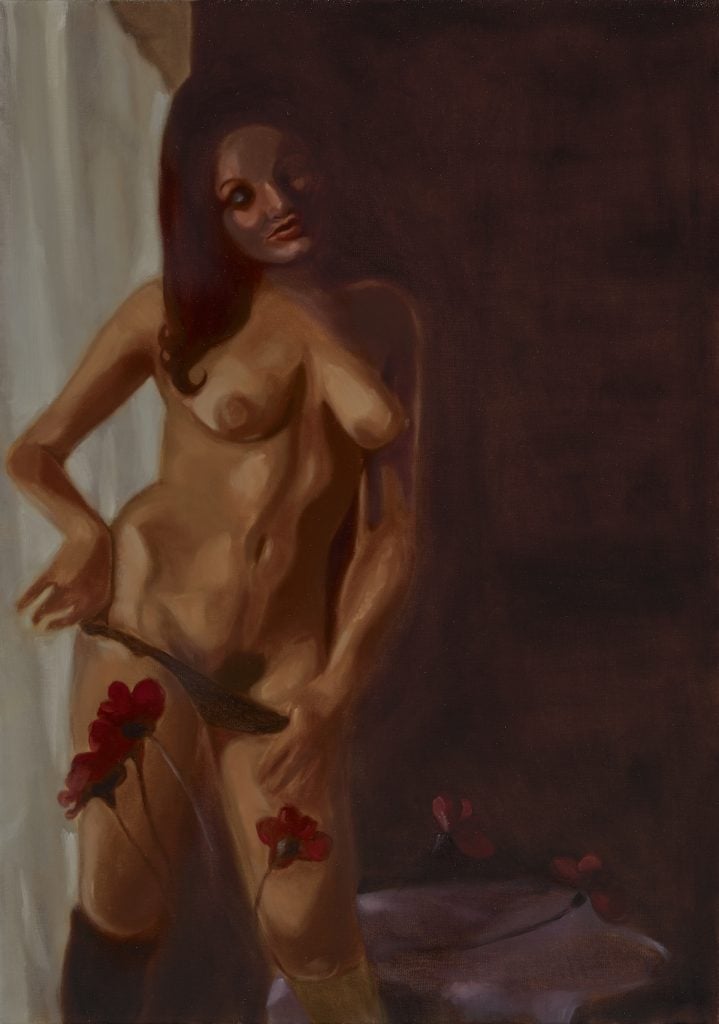
Somaya Critchlow, Count Me Out (2022). Courtesy Maximillian William
Akinkugbe also cites Rosa-Johan Uddoh and Sahara Longe as artists she admires, who are working with these ideas. Uddoh’s pieces in the 2022 show “Star Power” at Workplace in London replicate various renderings of the biblical figure of Balthazar from historical paintings and rearranged them into friendship groups.
Longe has introduced Black figures to traditional tableaux used by Old Masters. “Everyone is doing something slightly different,” said Akinkugbe, “but at the core is a desire to shift the gaze and reconsider the position of Black figures in European art traditions. They are all considering the position of Blackness in relation to art history, and also their own position.”
This approach has been pioneered by artists such as Kehinde Wiley and Titus Kaphar, whose works reframing historical paintings have led to prominent commissions, including Wiley’s 2018 presidential portrait of Barack Obama and Time magazine covers (Kaphar painted for the biweekly in June 2020, in response to the murder of George Floyd).
While contemporary artists deal with the weight of history, responsibility also sits with institutions deciding how to contextualize their works. Pallant House Gallery often displays contemporary and historical works together, inviting artists such as Grewal to select pieces from the collection to show alongside their own.
Martin highlights the importance of interrogating the context of historical works, which can be effective when placing the originals alongside the works they inspired. “It’s interesting how Tate Britain, in their recent rehang of the collection, placed a large watercolour by Pablo Bronstein in the room with Hogarth and his contemporaries. Bronstein’s work depicts an 18th-century molly house in London, where men who had sex with men would go, adding a queer lens to how we understand this moment in historic British painting.”
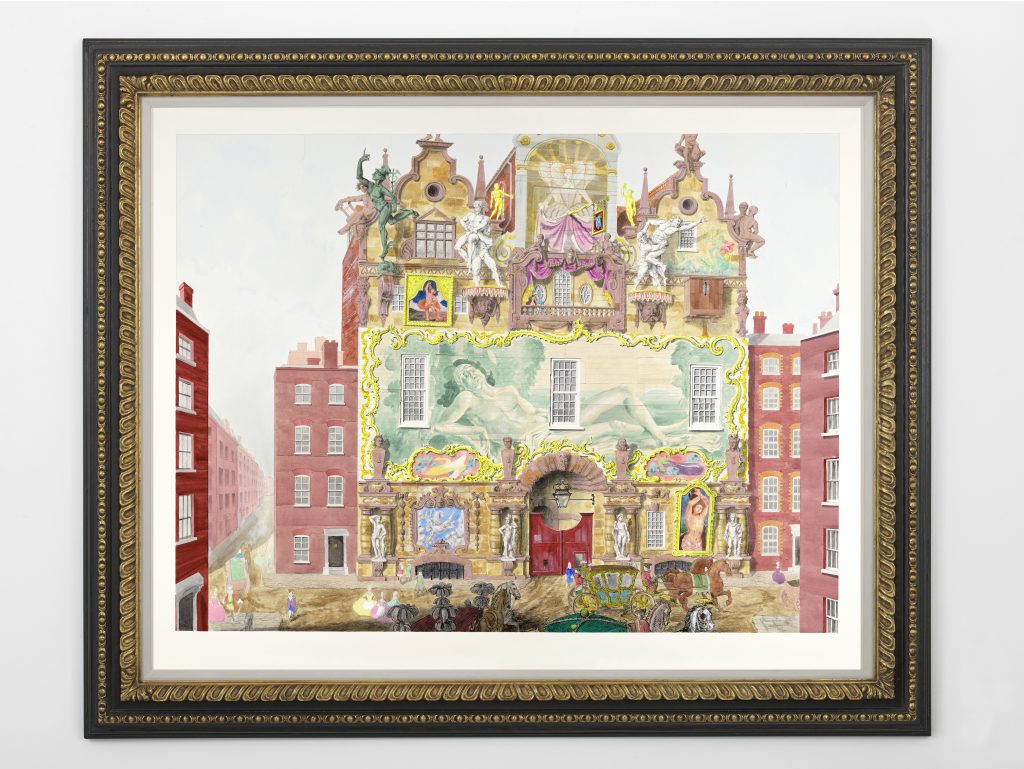
Pablo Bronstein, Molly House (2023). © Pablo Bronstein. Courtesy the artist and Herald St, London. Photo by Andy Keate.
This movement could be seen in three parts: it is driven by artists reworking the masterworks of the western canon, which sparks a wider cultural conversation examining damning aspects of history. Institutions respond by adding context for viewers to understand the dynamics inherent in their historical works, while challenging their own legacy.
“I think the culture and artists have driven us towards this,” said Akinkugbe, adding that the institutions have mostly been led by pressure from the outside. “If 2020 hadn’t happened, I don’t think this would be happening now in institutions.” She cites the new Fitzwilliam exhibition, “Black Atlantic: Power, People, Resistance”, as a positive example of an institution addressing its history and researching hidden narratives within its works. Items from the museum’s collection are shown alongside contemporary pieces by Walker, Donald Locke, Alberta Whittle and Keith Piper, which all reflect on historically silenced voices.
Akinkugbe also mentions the many instances in which white subjects have been named in historical artwork descriptions, along with pets and various other elements, while the Black figures are not. “Even if there is no information known [about a Black figure within a work], they can write about the role of Black people in society at that time,” she said.
Ultimately, the artists exploring these subjects and the curators and historians who push for the reframing of historical works see the value of keeping the originals alive within contemporary conversations. In doing so, their structures and impact can be considered and learned from, rather than simply being erased. “I am very opposed to the idea of putting things into storage because they’re difficult to deal with,” said Akinkugbe. “It goes against the idea of museums and academia to just put things away.”
More Trending Stories:
Four ‘Excellently Preserved’ Ancient Roman Swords Have Been Found in the Judean Desert